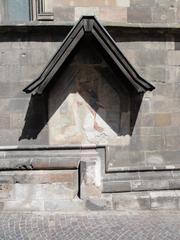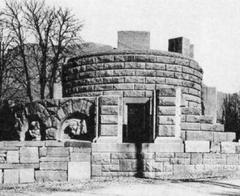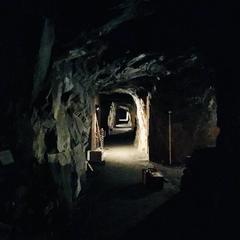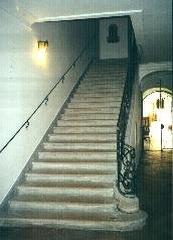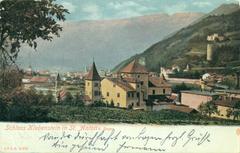Sigmundskron Castle: Visiting Hours, Tickets, and Historical Sites in Bolzano, Italy
Date: 14/06/2025
Introduction
Sigmundskron Castle (Castel Firmiano), dramatically perched atop a porphyry spur overlooking the convergence of the Adige and Isarco rivers, is one of South Tyrol’s oldest and most significant landmarks. Documented as early as 945 AD under the name “Formicaria,” the castle has served as a silent witness to centuries of regional power shifts, noble rule, and architectural transformation. Today, after extensive restoration, it houses the Messner Mountain Museum Firmian—a unique institution celebrating the relationship between humanity and mountains. With its strategic location near Bolzano, the castle offers not only panoramic Alpine vistas but also a deep dive into the region’s cultural and historical heritage (suedtirolerland.it; messner-mountain-museum.it).
Table of Contents
- Early Origins and Medieval Development
- Transformation under Duke Sigismund
- Role in Regional Power Struggles
- Decline and Symbolic Importance
- Modern Era: Restoration and the Messner Mountain Museum
- Architectural Features and Preservation
- Visiting Hours, Tickets, and Accessibility
- Getting There and Travel Tips
- Messner Mountain Museum Firmian: Exhibitions and Experience
- Practical Visitor Information and FAQs
- Sustainability and Heritage Preservation
- Nearby Attractions and Accommodation
- Conclusion
- References
Early Origins and Medieval Development
The earliest reference to Sigmundskron Castle dates to 945 AD, when it was known as “Formicaria” (later “Formigar”), a name possibly inspired by the hill’s shape or its bustling activity (suedtirolerland.it). By 1027, Emperor Conrad II granted the castle to the Bishop of Trient, cementing its role as an important administrative and military stronghold. The High Middle Ages saw the construction of formidable stone walls, some up to 5 meters thick, reflecting the defensive needs of the era.
Transformation under Duke Sigismund
In 1473, Duke Sigismund of Austria—known as “the Rich in Coin”—acquired and dramatically renovated the castle, bestowing upon it the name “Sigmundskron” (“Sigismund’s Crown”) and its distinctive silhouette. His expansions introduced late Gothic elements, including new towers and bastions, and reinforced the fortress to withstand emerging artillery warfare. Though these enhancements elevated the castle’s status, financial difficulties led to its eventual neglect (south-tirol.com).
Role in Regional Power Struggles
Throughout the Middle Ages and early modern period, Sigmundskron Castle played a pivotal role in Tyrolean power dynamics. Its formidable defenses ensured it was frequently contested, changing hands multiple times as South Tyrol’s political landscape evolved (trek.zone).
Decline and Symbolic Importance
By the 19th and 20th centuries, the castle lost its military relevance and fell into partial ruin. Its symbolic significance, however, increased—most notably in 1957, when over 30,000 South Tyroleans gathered at Sigmundskron to demand autonomy and protest unfulfilled promises from the Paris Agreement. This landmark rally, known as “Los von Trient,” established Sigmundskron Castle as a powerful symbol of regional identity and self-determination (wikipedia.org).
Modern Era: Restoration and the Messner Mountain Museum
Acquired by the Province of Bolzano in 1996, Sigmundskron Castle underwent careful restoration under architect Werner Tscholl. The goal: to blend heritage preservation with modern functionality using reversible, visually distinct elements like steel and glass (messner-mountain-museum.it). In 2006, the castle reopened as the Messner Mountain Museum Firmian, the flagship of Reinhold Messner’s six-museum project dedicated to mountain culture.
Architectural Features and Preservation
Fortified Walls and Towers
Sigmundskron’s most prominent feature is its massive ring wall, encircling both upper and lower castle sections. Several towers, including the iconic White Tower (Torre Bianca), punctuate the perimeter. The White Tower now houses exhibits on the 1957 autonomy rally and South Tyrol’s political evolution.
Chapel and Historic Interiors
The castle’s 10th-century Romanesque chapel is among its oldest structures, offering a glimpse into early spiritual life. Other interiors, such as the Knights’ Hall, have been repurposed for exhibitions and events.
Modern Adaptations
Contemporary architectural interventions, characterized by discreet glass roofs and steel walkways, preserve the medieval silhouette while ensuring weather protection and accessibility. Exhibition spaces are thoughtfully integrated, with pipes and cables hidden within original stonework. Panoramic terraces and walkways provide sweeping views of the Alps and Bolzano basin, underscoring the castle’s unique blend of nature and human ingenuity.
Visiting Hours, Tickets, and Accessibility
- Season: Generally open from the third Sunday in March to the second Sunday in November.
- Hours: 9:00 AM to 6:00 PM; closed on Thursdays (messner-mountain-museum.it; itinerary.expert).
- Tickets: Adult admission €10–€15; reduced rates for students, seniors, and children; children under 14 often enter free. Family and group rates available. Tickets can be purchased online or at the entrance (messner-mountain-museum.it).
- Guided Tours: Offered in multiple languages, with audio guides for self-paced exploration. Advance booking is recommended.
- Accessibility: Recent renovations have improved access, but some historic areas remain challenging for visitors with limited mobility. Key exhibition spaces are wheelchair-accessible; assistance is available upon request (kanoa.org.uk).
Getting There and Travel Tips
- By Bus: Lines from Bolzano city center (e.g., 132) stop near the castle; journey time is about 14 minutes (rome2rio.com).
- By Train: Regional trains stop at Sigmundskron/Ponte Adige station, followed by a 20-minute walk.
- By Car: Ample parking is available; exit the A22 at Bolzano Sud and follow signs.
- By Bike or Foot: Scenic routes through vineyards and woodlands are available for active visitors.
- Taxi: Approximately 8 minutes from Bolzano city center.
Messner Mountain Museum Firmian: Exhibitions and Visitor Experience
MMM Firmian is the centerpiece of Reinhold Messner’s mountain museum network. Unlike conventional museums, MMM Firmian guides visitors along a symbolic “mountain tour”—both indoors and outdoors—tracing the spiritual, cultural, and historical ties between people and mountains (messner-mountain-museum.it). Highlights include:
- Permanent Exhibitions: Explore mountain formation, religious significance, and mountaineering history.
- White Tower: Dedicated to South Tyrolean autonomy and the 1957 rally.
- Art and Artifacts: From Messner’s expeditions, including paintings, photographs, and symbolic items.
- Chapel and Ruins: Featuring medieval frescoes and historic architecture.
- Outdoor Installations: Panoramic terraces offering views of the Adige valley and surrounding Alps.
Special events, such as temporary exhibitions and annual cultural gatherings, make each visit unique.
Practical Visitor Information and FAQs
Facilities
- Museum Shop: Books, posters, souvenirs, and signed works by Reinhold Messner.
- Restaurant and Café: Located in former residential quarters, with garden seating and cellar ambiance.
- Restrooms: Available on site.
Frequently Asked Questions
Q: What are the opening hours?
A: 9:00 AM to 6:00 PM, closed Thursdays, from March to November (messner-mountain-museum.it).
Q: How much are the tickets?
A: Adults €10–€15; discounts for students, children, and groups.
Q: Are guided tours available?
A: Yes, in multiple languages with advance booking.
Q: Is the castle accessible for people with mobility issues?
A: Some areas are accessible; others remain challenging due to historic structures.
Q: Can I take photos?
A: Photography is allowed in most areas; flash and tripods may be restricted.
Q: Can I bring my pet?
A: Check the latest policy on the official website before your visit.
Sustainability and Heritage Preservation
Restoration efforts focus on preserving the castle’s historic essence while clearly distinguishing modern additions. The museum is committed to environmental sustainability and responsible tourism (suedtirol.info).
Nearby Attractions and Accommodation
- Nearby Sights: Bolzano’s historic center, Runkelstein Castle, and the South Tyrol Museum of Archaeology (home to Ötzi the Iceman).
- Accommodation: Options in Bolzano range from hotels to B&Bs, with varied price points (rome2rio.com).
- Transport: Bolzano is well connected by train and bus.
Conclusion
Sigmundskron Castle is a living testament to South Tyrol’s layered history and regional pride. Its sensitive restoration and transformation into the Messner Mountain Museum Firmian provide a compelling blend of medieval architecture, breathtaking Alpine views, and engaging cultural exhibitions. Whether you are passionate about history, mountain culture, or simply seeking a memorable day out near Bolzano, Sigmundskron Castle is a must-visit destination. For the most current information on hours, tickets, and events, always consult the official Messner Mountain Museum website.
Enhance your experience: Download the Audiala app for audio guides, interactive maps, and travel tips tailored to South Tyrol’s heritage sites.
